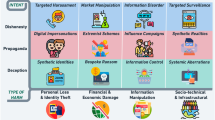Abstract
Some of the systems used in natural language generation (NLG), a branch of applied computational linguistics, have the capacity to create or assemble somewhat original messages adapted to new contexts. In this paper, taking Bernard Williams’ account of assertion by machines as a starting point, I argue that NLG systems meet the criteria for being speech actants to a substantial degree. They are capable of authoring original messages, and can even simulate illocutionary force and speaker meaning. Background intelligence embedded in their datasets enhances these speech capacities. Although there is an open question about who is ultimately responsible for their speech, if anybody, we can settle this question by using the notion of proxy speech, in which responsibility for artificial speech acts is assigned legally or conventionally to an entity separate from the speech actant.
Similar content being viewed by others
Notes
The term “actant” is due to Latour (1999), who uses it to explain phenomena in terms not reducible to individuals, social groups, institutions or artefacts on their own. My usage is much more limited and is not intended to rule out such a reduction.
This passage was brought to my attention by Salinga and Wuttig (2011).
This is not to say that hypotheses are not truth-evaluable, only that their implicit purpose is not always undermined if they turn out to be false. Some hypotheses (such as those putting forward a claim to be investigated) need only be plausible in order to be satisfactory. Others, such as those used in proving a reductio ad absurdum, need not even be plausible in order to be satisfactory.
Insincere assertions, which show a kind of attunement to the world without attempting to represent it accurately, would be an exception.
Not all of the criteria are susceptible of satisfaction to a degree, but the criterion of originality of content is. There is no obvious threshold of originality beyond which we ascribe unambiguous authorship to a given entity. For example, in the adaptation of a story one has heard earlier for a new purpose or audience, there is no obvious point at which one becomes a co-author or sole author.
For the moment we shall set aside doubts about whether the notion of agency can apply to artificial legal persons such as corporations.
References
Austin, J. L. (1962). How to do things with words. Oxford: New York.
Barber, A. (2010). Idiolects. In E. N. Zalta (Ed.), The stanford encyclopedia of philosophy (Winter 2010 edition). http://plato.stanford.edu/archives/win2010/entries/idiolects.
Bellia, A. J., Jr. (2001). Contracting with electronic agents. Emory Law Journal, 50, 1047–1092.
Castagnoli, F. (1971). Orthogonal town planning in Antiquity. Cambridge: MIT Press.
Dale, R., Geldof, S., & Prost, J.-P. (2005). Using natural language generation in automatic route description. Journal of Research and Practice in Information Technology, 37(1), 89–105.
Davidson, D. (1986). A nice derangement of epitaphs. In E. Lepore (Ed.), Truth and interpretation: Perspectives on the philosophy of Donald Davidson. Cambridge, MA: Blackwell.
Dennett, D. (1991). Consciousness explained. Boston: Little, Brown and Company.
Descartes, R. (1985). Discourse on the method. In The philosophical works of descartes, vol. I (J. Cottingham, R. Stoothoff, & D. Murdoch, Trans.). New York: Cambridge University Press.
Grice, H. P. (1989). Studies in the ways of words. Cambridge, MA: Harvard University Press.
Hovy, E. H. (1990). Pragmatics and natural language generation. Artificial Intelligence, 43, 153–197.
Jurafsky, D., & Martin, J. H. (2009). Speech and language processing: An introduction to natural language processing, computational linguistics, and speech recognition (2nd Edn.) Lebanon: Prentice Hall.
Klippel, A., Tappe, H., & Habel, C. (2003) Pictorial representations of routes: Chunking route segments during comprehension. In C. Freksa et al. (Eds.), Spatial cognition III, vol 2685 (pp. 11–33). New York: Springer.
Klippel, A., & Winter, S. (2005) Structural salience of landmarks for route directions. In A. G. Cohn & D. M. Mark (Eds.), COSIT 2005, LNCS 3693 (pp. 347–362). New York: Springer.
Latour, B. (1999). Morale et Technique: la Fin des Moyens. Réseaux, 100, 39–58.
Macherey, K. (2009). Statistical methods in natural language understanding and spoken dialogue systems. Dissertation, RWTH Aachen University.
Madsen M. W. (2009). The limits of machine translation. Masters Thesis, University of Copenhagen.
McLuhan, M. (1964). Understanding media: The extensions of man. New York: McGraw Hill.
Portet, F., et al. (2009). Automatic generation of textual summaries from neonatal intensive care data. Artificial Intelligence, 173(7–8), 789–816.
Reiter, E., & Belz, A. (2009). An investigation into the validity of some metrics for automatically evaluating natural language generation systems. Computational Linguistics, 35(4), 529–558.
Richter, K.-F., Tomko, M., & Winter, S. (2008). A dialog-driven process of generating route directions. Computers, Environment and Urban Systems, 32, 233–245.
Salinga, M., & Wuttig, M. (2011). Phase-change memories on a diet. Science, 332, 543.
Strapparava, C., Stock, O., & Mihalcea, R. (2011). Computational humour. In P. Petta, et al. (Eds.), Emotion-oriented systems (pp. 609–634). Berlin: Springer.
Strawson, P. F. (1971). Intention and convention in speech acts. In Logico-linguistic papers. London: Methuen.
Weizenbaum, J. (1966). ELIZA-A computer program for the study of natural language communication between man and machine. Communications of the ACM, 9(1), 36–45.
Williams, B. (1973). Deciding to believe. In Problems of the self (pp. 136–151). Cambridge: Cambridge University Press.
Young, R. M. (1999). Using Grice’s maxim of quantity to select the content of plan descriptions. Artificial Intelligence, 115, 215–256.
Author information
Authors and Affiliations
Corresponding author
Rights and permissions
About this article
Cite this article
Nickel, P.J. Artificial Speech and Its Authors. Minds & Machines 23, 489–502 (2013). https://doi.org/10.1007/s11023-013-9303-9
Received:
Accepted:
Published:
Issue Date:
DOI: https://doi.org/10.1007/s11023-013-9303-9




